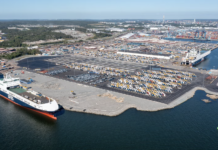
The increasing focus on the negative environmental impact of single-use plastic items and moves to eliminate them from the global supply chain has reportedly caused many long-time users to reconsider their use of flexibags.
Flexibags offer an alternative to ISO tank containers for shipping food-grade liquids and non-hazardous chemicals. Since the Coronavirus outbreak began to worsen, disruption to the supply of containers suitable to carry flexibags has pushed shippers to consider alternatives.
“While cargo has always moved back and forth between modes, we saw a real uptick in the conversion back to tank containers in some markets that began in 2019 and continued into 2020 when many food grade and chemical customers stepped up the focus on the long term sustainability of their businesses,” reveals Michael Kramer, President of Stolt Tank Containers (STC).

Given its global activity and widespread customer base, STC has seen an increasing trend in the conversion of cargo back into tank containers.
It is also receiving requests to evaluate various supply chain alternatives, particularly in the food-grade and simple or non-hazardous chemical trade globally.
This momentum around the conversion back to tank containers was rising before Covid-19, which has now increased the trend further due to the disruption in dry cargo container flows from China, which could force a shift in the industry. “We expect some cargo to remain in tank containers when the pandemic is resolved, and attention is again placed on sustainability,” predicts Kramer.
Before the virus developed into a global pandemic, the global shipping and logistics industries were focused on minimising any detrimental effects they may have on the environment. The shift from single use flexibags back to tank containers can be seen as an example of that.
“We hope this trend continues as STC is [also] focused on minimising its environmental footprint,” says Kramer who explained that tank containers can easily last well over 30 years and depending on the trade, can be used up to four or five times in the deep sea trade and significantly more times in the short sea or intra-European markets.
“At the end of their useful life, approximately 90-95% of a tank container can be recycled. Flexibags, on the other hand, are a single-use item representing over 7,000 single-use consumer plastic bags each. While technology has improved, not all bags can be cleaned before being sent to landfill, and this poses other environmental concerns.”
Katerina Kerr
Tank Container Correspondent








